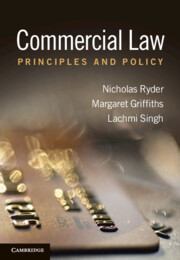Book contents
- Frontmatter
- Contents
- Preface
- List of abbreviations
- Table of Statutory Provisions
- Table of Cases
- Part 1 Agency
- Part 2 Sale of Goods and Services
- Part 3 International Trade and Sales
- Part 4 Tortious Liability for Defective Products
- Part 5 Unfair Commercial Practices
- Part 6 Banking and Finance Law
- Part 7 Consumer Credit
- Bibliography
- Index
Part 6 - Banking and Finance Law
Published online by Cambridge University Press: 05 August 2012
- Frontmatter
- Contents
- Preface
- List of abbreviations
- Table of Statutory Provisions
- Table of Cases
- Part 1 Agency
- Part 2 Sale of Goods and Services
- Part 3 International Trade and Sales
- Part 4 Tortious Liability for Defective Products
- Part 5 Unfair Commercial Practices
- Part 6 Banking and Finance Law
- Part 7 Consumer Credit
- Bibliography
- Index
Summary
Introduction
Part 6 deals with banking and finance law. Chapter 1 identifies and explains the policies adopted by the United Kingdom government towards the banking sector. The chapter begins by providing a brief historical account of the development of banking regulation from the creation of the Court of Alderman in the seventeenth century to the Financial Services Bill (2011). The chapter identifies the contrasting policies adopted by the Labour government (1997–2010) and those proposed by the Coalition government.
Chapter 2 sets out to provide a detailed overview of the law relating to banks. The chapter begins by attempting to answer what in theory should be a very simple question – what is a bank? However, it will become clear that this is quite a difficult question to answer. Chapter 2 goes onto define a ‘customer’ and then progresses to highlight the very complicated relationship between a bank and its customers. Particular attention is paid to the duties a bank owes to its customers, including, for example, the duty of confidentiality. The chapter also outlines the different types of bank accounts offered to customers and deals with some of the legal issues relating to cheques, e-banking and the regulation of bank accounts.
- Type
- Chapter
- Information
- Commercial LawPrinciples and Policy, pp. 405 - 406Publisher: Cambridge University PressPrint publication year: 2012



